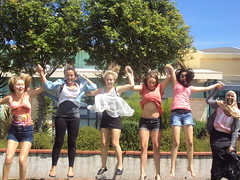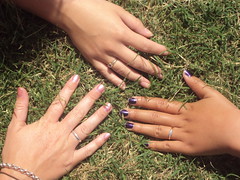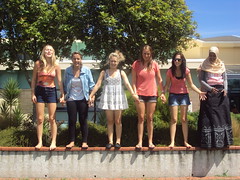Tutorial six is going to be based around the internet and online communities of personal occupation and interest. The three online communities I have researched are:
http://www.facebook.com/
The purpose of this social networking site is to allow individuals to meet and socialise with anyone around the world through the internet. It is a good way to keep in contact with friends, family and others overseas or in the same country. Photos and videos can be uploaded and shared and comments and status's can be pasted onto the individuals personal page. Facebook provides the right to have privacy. For example, you are able to change your privacy settings so that anybody can see your page or so that only your friends can view your page. Privacy is an important service to have on facebook as many people want to avoid any negativity on their page.
http://twitter.com/
Twitter is similar to facebook in the way of keeping up to date with your friends and writing status's etc. Difference is, on twitter there is no adding or declining a person, anyone can view your twitter account. This is good for individuals that want to keep up with their favorite celebrity or industry peer. People 'tweet' their feelings or things that are happening at that point in time. The site is very interactive as you can view basically anybody's twitter page and be updated in just seconds! It is the best way to share and discover what is happening right now.
Here is an example of the types of topics (status's) that are discussed/said on twitter:
Top Tweets
http://secondlife.com/
Second life is an online 3D virtual world where users can socialise, customise a person, connect and create using free voice and texts, and travel away to your favorite destinations. It is another way of socialising but with fake made up people. People enjoy taking part in second life because it fosters a sense of community and allows you to experience other types of experiences for example, schizophrenia. Some people seek fun and entertainment but others may seek a sense of self worth and can make them feel better about themselves being able to choose how their (virtual world life) goes.
"When you enter second life for the first time, you will start on welcome island. This area is designed to quickly teach you the basics of second life including walking, zooming with your camera, chatting, standing, sitting, flying and teleporting. Along the way you will be rewarded with entertaining surprises" (Second life website, n.d.).
Here is an example of the types of things you can do on Second life:
Community in Second Life
Connect with Friends and Meet New People
In Second Life, there's always someone to talk to, dance with, learn from or perhaps even love. You can meet people all over the world without ever leaving your home. And here, there's no jet lag and the clubs are always open.

ETHICAL ISSUES:
BuisnessDictionary.com (2011) defines ethical issues as, "problem or situation which requires a person or organisation to choose between alternatives that must be evaluated as right (ethical) or wrong (unethical).
Here is a link to an interesting online article about the ethical issues included in second life in the past including copyright infringement, spamming, and using multiple identities.
http://resources.metapress.com/pdf-preview.axd?code=043482g728155x8x&size=largest
Ethical issues that relate to facebook is mainly focused on privacy. Social networking sites such as Facebook share information about the user over the internet, where it can be freely accessed by anyone. This is where issues of privacy to the individual arise. Facebook has 11 Social & Ethical Issues of Information Systems specific to facebook.
Twitter is a reasonably safe social network to be a part of. Here is a link to a website on twitter ethical dilemmas that may occur. Something to think about.
http://www.pr-squared.com/index.php/2010/01/tweeting-under-false-circumstances-social-media-ethical-dilemmas
We all love real life geographical communities like our local community, neighbourhood or suburb. But online communities are increasingly getting better. People are communicating through internet just as much as face to face. Although these virtual communities can become 'addictive' they are a great way of communicating and provide a simple way of getting through to others.
Online communities do have some downfalls. For example, even though we can put a smiley face or sad face on our facebook comments and write what we think, it can still very easily come across the wrong way to the person reading it. This is something that lets communicating online down as you are not having that actual contact with the person and can not see facial expressions etc like traditional communities do.
References:
BuisnessDictionary.com. (2011).
What is ethical issues? Retrieved March 23, 2011 from:
http://www.businessdictionary.com/definition/ethical-issue.html
Second life website. (n.d.).
What is second life? Retrieved March 23, 2011 from:
http://secondlife.com/whatis/?lang=en-US







